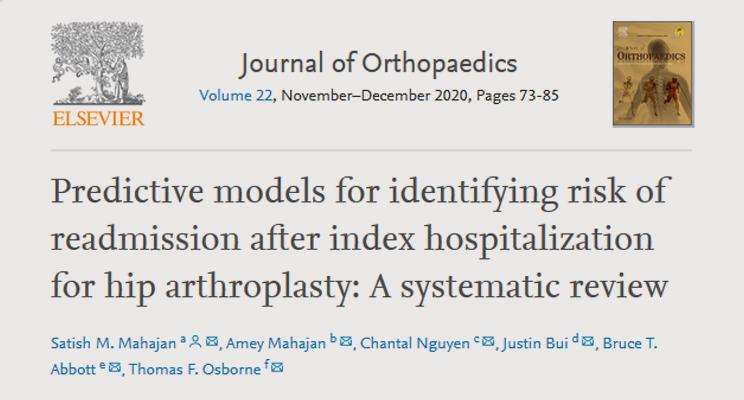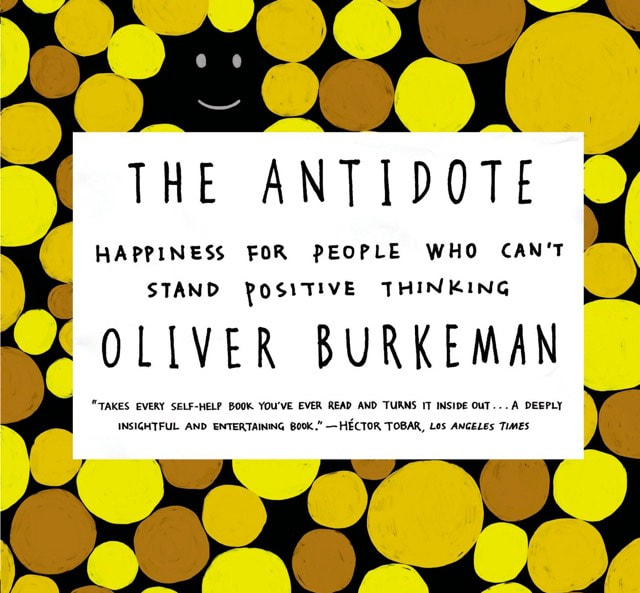|
Arthroplasty surgeries have received increased scrutiny over the past decade as surgical volume has exploded and the movement toward value-based care has solidified. For the patient, this translates to an increased focus on post-operative care, transitions, and complications.
The C2OPS team, in articles published in the Journal of Orthopaedics (published) and Arthroplasty Today (in production), comprehensively analyzed existing literature on readmission outcomes and care transitions based on predictive models. Readmissions are a key hospital performance measure and vital to the patient journey, especially so for hip arthroplasties (THA) and knee arthroplasties (TKA) readmissions. With continued efforts in the predictive modeling space, we can look forward to reduced costs and better healthcare value for the patient.
0 Comments
While meta-analysis for randomized controlled trials (RCTs) is a well-established procedure, meta-analyzing scores of studies that build observational, diagnostic predictive models is considerably harder. These studies usually report confusion matrices and AUC/ROC metrics rather than more conventional mean differences or odds ratios, making the standard techniques for meta-analysis fairly unusable.
Fortunately, Debray and team recently published an insightful paper that provides guidelines, estimators and approaches for conducting meta-analysis of predictive modeling studies. It is available at the link below, and we recommend that anyone working in the predictive analytics area checks it out! https://www.ncbi.nlm.nih.gov/pmc/articles/PMC6728752/ 11/11/2019 0 Comments Book Recap: The Antidote: Happiness For People Who Can't Stand Positive Thinking, by Oliver Burkeman“Eliminate the word ‘impossible’ from your vocabulary!”
It’s epithets like this one that Oliver Burkeman goes after in his book The Antidote, unnecessarily cheesily subtitled Happiness For People Who Can’t Stand Positive Thinking. Don’t let the subtitle mislead you, though - the book itself is a whirlwind tour of unorthodox philosophical and psychological approaches to achieving some degree of inner fulfillment, written with a pleasant degree of snarky British humor and a bevy of compelling and logical concepts. The first chapter sets the stage by pointing out many of the flaws in the hyper-optimistic, ‘cult of optimism’, always-enthusiastic school of positive thinking. Burkeman accurately observes that endlessly positive thinking not only requires constant reinforcement, leading to diminishing returns, but also tends to set a standard of ‘happiness’ that for many people will continually be just out of reach, even as they make progress toward their goals. (To be clear, Burkeman is not critiquing optimism in these pages, but rather the school of positive thinking that insists that regulating one’s thoughts to be positive will lead to happiness.) Each of the next six chapters is dedicated to a modality of thought that the author brands as a ‘negative’ approach to happiness - however, while reading those chapters, one feels that ‘unorthodox’ or ‘unusual’ is a better descriptor for what Burkeman is studying than ‘negative’. These include studies of Stoic (with a capital S) philosophy, which is becoming increasingly popular in ‘productivity guru’ circles, meditation practices espoused by Buddhism, obsessions with goal-setting, and examinations of our reluctance to confront our own previous failures and the thought of death. The most enjoyable aspect of the book is that the discourse is thorough, with Burkeman stitching reader-friendly explanations together with quotations from writers and scientists. Each chapter is also sprinkled with takeaways that can be applied incrementally in one’s own life, such as self-questions, moments of pause, and meditations. For example, one particularly interesting reflection is: “Why do you need to feel motivated to do something before you actually do it? Why not just get to work regardless?” Such a question perfectly fits the unorthodox angle this book brings to discussions of happiness. Though the book doesn’t explicitly aim to be persuasive, it succeeds in doing so: there is an undercurrent of ‘matter of factness’ that runs through the chapters that keeps the reader nodding along. Even in more abstract concepts, such as disentangling our stream of chattering thoughts from our ‘self’ (Eckhart Tolle, Alan Watts), Burkeman is quick to provide explanatory sentences that keep the discussion from becoming too hand-wavy. In summary, The Antidote is a compelling and enjoyable read that imparts the reader with a refreshingly grounded take on finding fulfillment - especially if you’ve had enough of the relentless positivity marketing that is mainstream today. While many people discovered this book through the recommendations of “Getting Things Done” founder David Allen (as did I), the book is by no means limited to self-help or productivity topics, and was well worth the time. Most of us are aware that our collective attention spans and capacity to get challenging work done effectively have taken a beating due to a preponderance of distractions ranging from social media to cell phone notifications to instant messaging and email. Author and Georgetown University professor Cal Newport makes this issue his headliner in Deep Work: a manifesto on principles and strategies for combating our distractions and achieving “deep work”, or “professional activities performed in a state of distraction-free concentration that push your cognitive capabilities to their limit.”
Newport spends the first half of the book espousing the reasons why deep work is valuable, rare and important — and he does a great job convincing the reader. Rather than relying on the overused format of cherry-picking case studies, Newport refreshingly provides a bevy of logical, consistent arguments and examples that fit together well and bring the reader to agreement. He also introduces the reader to a cast of characters who, in some form or another, embody some mix of deep work (Newport), strong work habits (Clear) and flow state (Csikszentmihalyi). The latter half of the book presents a series of strategies for becoming a deep worker, ranging from quitting social media — one of the more extreme suggestions — to creating specific time blocks during which you allow yourself to check email. One of my favorite techniques is the Roosevelt dash (modeled after Theodore Roosevelt): the practice of dramatically reducing the amount of time you typically give yourself to complete a task, thereby forcing yourself into blisteringly intense focus in order to complete it. For example, I could shut out all distractions by giving myself a mere 30 minutes to write and upload this post. While not all of Newport’s suggestions are this concrete and achievable, there are many of them, allowing the reader to pick and choose to their liking. Deep Work would not have been as enjoyable without Newport’s backing up of his more ideological first half with his more concrete, strategic second half. Given that balance, and the fact that the book is an easy read that could be finished in a weekend, Deep Work is well worth your time. The twin primes conjecture is one of the most important and difficult questions in mathematics. Two mathematicians have solved a parallel version of the problem for small number systems.
Available at Quanta Magazine: https://www.quantamagazine.org/big-question-about-primes-proved-in-small-number-systems-20190926/ We enjoyed this systematic review quite a bit. Useful to bear in mind while constructing and validating deep learning models.
Faes, Livia and Liu, Xiaoxuan: Deep Learning Under Scrutiny: Performance Against Health Care Professionals in Detecting Diseases from Medical Imaging - Systematic Review and Meta-Analysis (May 8, 2019). Available at SSRN: https://ssrn.com/abstract=3384923 |
AuthorArticles, books, research and other items of interest from the C2OPS team. Archives
June 2020
Categories |
Search by typing & pressing enter




 RSS Feed
RSS Feed